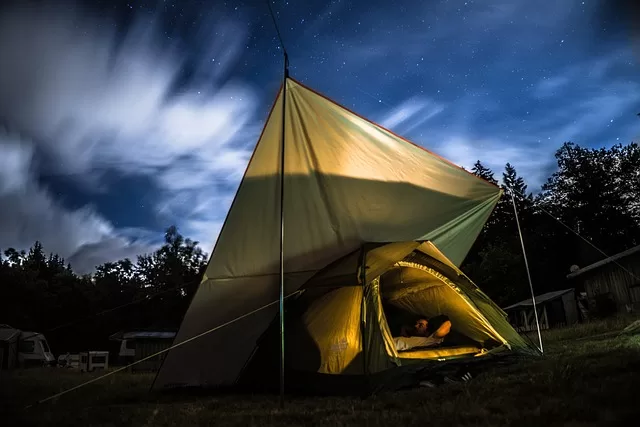Don’t just go out there to connect to nature and get rejuvenated without looking for ways of protecting the environment while camping. Always remember that camping though fun and exciting impacts the environment greatly. Lasting effects such as litter, soil erosion, and harm to wildlife are some of the negative impacts of camping. It is important therefore that every camper or one seeking to enjoy the great outdoors looks out for the environment as well by looking for ways to protect the environment while camping, to preserve it for generations to come.
This ultimate guide to protecting the environment while camping explores ways to keep the environment safe and less tortured while camping. There are several concepts such as Leave No Trace principles, as well as other safety and environmental protection steps like tips for selecting a campsite, campfire safety, responsible camping waste management and sanitation, as well as respecting and dealing with wildlife. With these tips, you will reduce your impact on the environment, protecting the environment for generations to come, while still enjoying the beauty and tranquility of the outdoors.
Choosing a Campsite
Camping can have a significant impact on the environment, and choosing the right campsite or right spot for setting up camp can help minimize that impact. When you choose an inappropriate campsite, it can lead to soil erosion, damage to vegetation, disruption of wildlife habitats, and other environmental problems. Additionally, camping in unauthorized or prohibited areas can lead to fines or legal penalties.
What to Consider When Selecting a Campsite
Here are the factors to consider when selecting a campsite when looking for ways of protecting the environment while camping.
Regulations and Permissions
It is important to select a campsite that is authorized and permitted for camping. Look for designated campsites in established campgrounds, national or state parks, or other public lands. Always check with the relevant authorities for camping regulations and restrictions.
Location
Consider the location of the campsite. Choose a site that is away from sensitive habitats, such as wetlands, fragile ecosystems, or areas with rare or endangered species. Avoid camping near water sources to prevent contamination and disturbance to aquatic life.
Terrain
Select a campsite that has a durable surface, such as rocky or gravelly areas, to minimize soil erosion and vegetation damage. Avoid setting up camp on soft or fragile soil, such as meadows or wetlands, as these areas are more susceptible to damage.
Accessibility
Choose a campsite that is easily accessible and does not require creating new trails or damaging vegetation to access. Avoid creating shortcuts or new trails, as these can lead to soil erosion and damage to plant life.
Weather
Consider the weather conditions when selecting a campsite. Avoid camping in areas prone to flash floods, landslides, or other natural hazards. Choose a site that is sheltered from strong winds and is not at risk of being hit by falling trees or branches.
Tips for Setting Up Camp in a Way that Minimizes Environmental Impact
Pitch Tents on Durable Surfaces
Know how to pitch a tent like a pro and this includes knowing where to set up camp. Pitch tents on durable surfaces such as rock, gravel, or compacted soil. Avoid pitching your tent or setting up camp on soft or fragile soil, such as meadows or wetlands, as these areas are more susceptible to damage.
Use Established Campsites
Use established campsites whenever possible to minimize the impact on the environment. Do not create new campsites or trails.
Respect Wildlife
Know the guidelines for dealing with wildlife while enjoying the great outdoors. Observe wildlife from a distance and do not disturb or feed them.
Managing Waste to Protect the Environment While Camping
Proper waste management is crucial for protecting the environment while camping. Campers should take responsibility for their waste and ensure that it is disposed of properly to minimize the impact on the environment.
Pack Out What You Pack In
Campers should always pack out what they pack in. This means bringing all waste, including trash, food waste, and personal hygiene products, out of the campsite and properly disposing of it in designated trash receptacles. Leaving trash or waste behind can harm the environment, attract wildlife, and make the campsite unsanitary for future campers.
Leave No Trace
Practice “leave no trace” principles by packing out all trash and minimizing the impact of human activity on the environment.
Campfires
If campfires are allowed, master the art of building a perfect campfire, use established fire rings or pits, and only burn small sticks and twigs. Do not burn trash, food waste, or other non-organic materials. Be conscious of campfire safety by extinguishing the fire completely before leaving.
Food Storage
Store food in bear-proof containers or hang it in trees away from the campsite to prevent attracting wildlife. Here are the best camping coolers and storage to consider. Also, follow these tips for keeping your food fresh and your drinks cold while camping.
Use Biodegradable Products
For camping toiletries and hygiene, use biodegradable soap, toothpaste, and other personal care products to minimize the impact on the environment.
Dispose of Waste Properly
Always dispose of waste properly when camping. Follow the guidelines for waste management and sanitation while camping like using designated trash receptacles and recycling bins and avoiding littering or burying waste. Pack out your food properly and dispose of it, as it can attract wildlife and create unsanitary conditions.
Consider Using a Composting Toilet
Consider using a composting toilet to manage waste. Composting toilets use natural processes to break down waste and convert it into nutrient-rich compost. This minimizes the impact on the environment and eliminates the need for traditional sewage systems. However, you must properly clean and maintain composting toilets regularly to ensure proper function and hygiene.
Minimizing Impact on Nature
When seeking for how to protect the environment while camping, you are probably thinking of how to minimize your impact on the environment and natural habitats right?. To reduce your impact on the environment there are certain guidelines to follow.
Avoid Damaging Vegetation
When setting up camp, you should choose a site that is already disturbed and avoid damaging vegetation. Walking or driving on vegetation can harm the delicate balance of ecosystems and reduce the ability of plants to grow and reproduce. Also, avoid cutting down trees or damaging plants for firewood or other uses.
Do Not Disturb Wildlife
Stay away and avoid disturbing wildlife and their habitats. This includes not feeding wildlife, not approaching or touching animals, and not disturbing nests or dens. Also avoid making loud noises or playing music, which can disrupt the natural soundscape and scare away animals.
Keep a Safe Distance From Bodies of Water
When camping near bodies of water, keep a safe distance to avoid disturbing aquatic life and their habitats. This includes not swimming or bathing in natural water sources, which can introduce pollutants and harm aquatic life. Avoid throwing trash or waste into bodies of water and should use designated waste receptacles instead.
Avoid Using Soap in natural water Sources
Avoid using soap or other personal hygiene products in natural water sources. These products can introduce pollutants and chemicals into the water, harming aquatic life and their habitats. Instead, use biodegradable soap and wash at least 200 feet away from natural water sources.
Respect for Wildlife
Respecting wildlife is crucial for protecting the environment while camping. Wildlife plays an essential role in maintaining healthy ecosystems and natural habitats. When camping, it is important to respect wildlife and their habitats and to minimize your impact on their natural behaviors.
Guidelines For Interacting With Wildlife
When encountering wildlife, campers should follow these guidelines to minimize their impact on natural habitats and behaviors:
- Keep a safe distance: Keep a safe distance from wildlife to avoid disturbing them or their habitats.
- Do not feed wildlife: Feeding wildlife can disrupt their natural behaviors and make them dependent on human food sources.
- Do not approach or touch animals: Approaching or touching animals can scare them and create a dangerous situation for both the animal and the camper.
- Respect nesting and denning sites: Nesting and denning sites are critical for the survival of many species. Avoid disturbing these sites and keep a safe distance.
Tips for Minimizing the Impact on Wildlife While Camping
Here are some tips to help you minimize your impact on wildlife while camping:
- Store food properly: Store food in designated containers and keep them away from sleeping areas to avoid attracting wildlife.
- Keep a clean campsite: Keep your campsite clean and free of food waste or other attractants that could draw in wildlife.
- Use designated trails: When hiking, use designated trails to avoid damaging vegetation and disrupting wildlife habitats.
- Respect noise levels: Avoid making loud noises or playing music that could disrupt the natural soundscape and scare away wildlife.
Campfire Safety
Campfires are a popular activity when camping, but it is important to prioritize safety and protect the environment when building and maintaining a fire. Campfire safety is crucial for protecting the environment and preventing wildfires. When building and maintaining a campfire, campers should prioritize safety and follow guidelines to minimize their impact on the environment.
Guidelines for Building and Maintaining a Campfire
Here are some guidelines for building and maintaining a campfire when seeking for ways of protecting the environment while camping:
- Follow fire regulations and guidelines: Check local regulations and guidelines for building and maintaining campfires. Some areas may have fire bans or restrictions due to high fire danger.
- Use established fire rings or pits: Use established fire rings or pits, rather than creating new fire pits, to minimize their impact on the environment.
- Keep the fire small: Keep the fire small and manageable, using only small sticks and twigs to prevent the fire from getting out of control.
- Extinguish the fire completely: Make sure to fully extinguish the fire before leaving the campsite or going to bed. This means pouring water over the fire and stirring the ashes until they are cool to the touch.
Alternatives To Campfires
There are alternative ways to enjoy a campfire experience without building an actual fire. Here are some alternatives to campfires:
- Use a portable campfire pit: Portable campfire pits are available for purchase or rental, and can provide a safe and controlled fire experience.
- Use a propane or gas stove: Propane or gas stoves can be used for cooking or providing heat, without the risk of a campfire.
- Use battery-powered or solar-powered lights: Battery-powered or solar-powered lights can provide a warm and cozy atmosphere without the risk of an actual fire.
Leave No Trace Principles
The Leave No Trace Principles are a set of guidelines created by the Leave No Trace Center for Outdoor Ethics to promote responsible outdoor recreation and minimize the impact on the environment. There are seven principles:
- Plan ahead and prepare
- Travel and camp on durable surfaces
- Dispose of waste properly
- Leave what you find
- Minimize campfire impact
- Respect wildlife
- Be considerate of other visitors
How to Apply Them While Camping
Here are some ways to apply the Leave No Trace Principles to protect the environment while camping:
Plan Ahead and Prepare
Plan your trip ahead of time and be prepared with the necessary equipment and supplies to minimize their impact on the environment.
Travel and Camp on Durable Surfaces
You should stick to established trails and campsites to avoid damaging vegetation and wildlife habitats. When setting up camp, choose a durable surface, such as gravel or sand, rather than setting up on fragile or sensitive areas.
Dispose of Waste Properly
Pack out all trash and dispose of human waste properly, either by burying it in a cathole at least 200 feet away from water sources or using a portable toilet.
Leave What You Find
Leave natural and cultural resources, such as rocks, plants, and artifacts, undisturbed for others to enjoy.
Minimize Campfire Impact
Follow the proper guidelines for building and maintaining a campfire to minimize the impact on the environment and consider alternatives to campfires, such as portable campfire pits.
Respect Wildlife
Only observe wildlife from a safe distance and avoid disturbing them or their habitats.
Be Considerate of Other Visitors
Always stay respectful of other visitors by keeping noise levels down and giving them space to enjoy their outdoor experience.
Conclusion
Protecting the environment while camping is essential for preserving the natural beauty and ecosystems of our outdoor spaces. By following the tips and guidelines outlined in this discussion, campers can minimize their impact on the environment and promote responsible outdoor recreation. This includes selecting the right campsite, managing waste properly, minimizing the impact on nature, respecting wildlife, practicing campfire safety, and following the Leave No Trace Principles. It is our responsibility as outdoor enthusiasts to take care of the environment and ensure that future generations can enjoy the same outdoor experiences that we do.


























